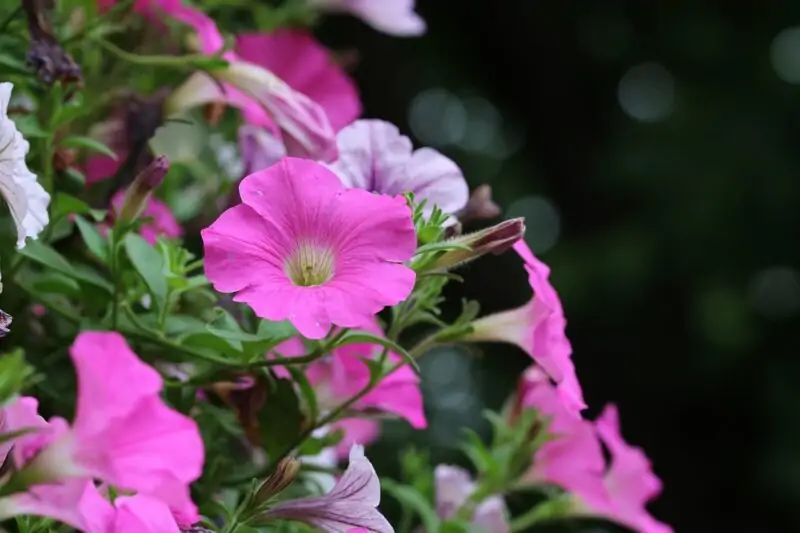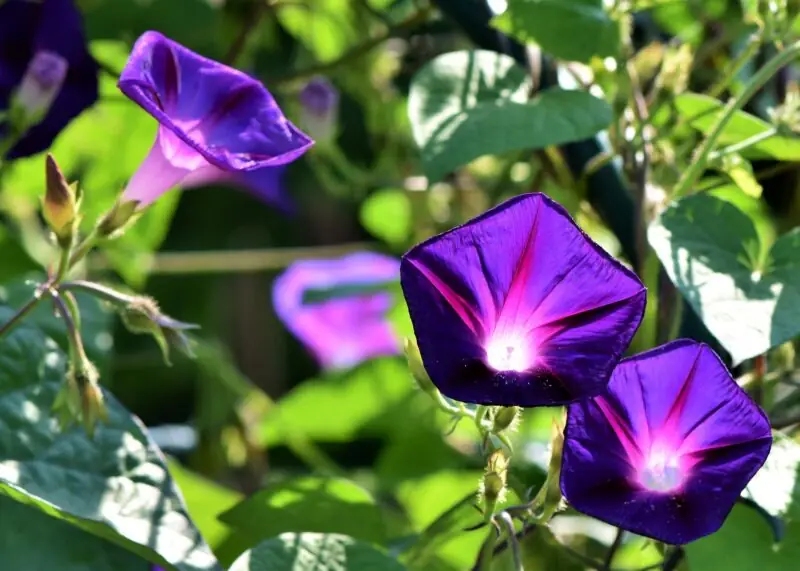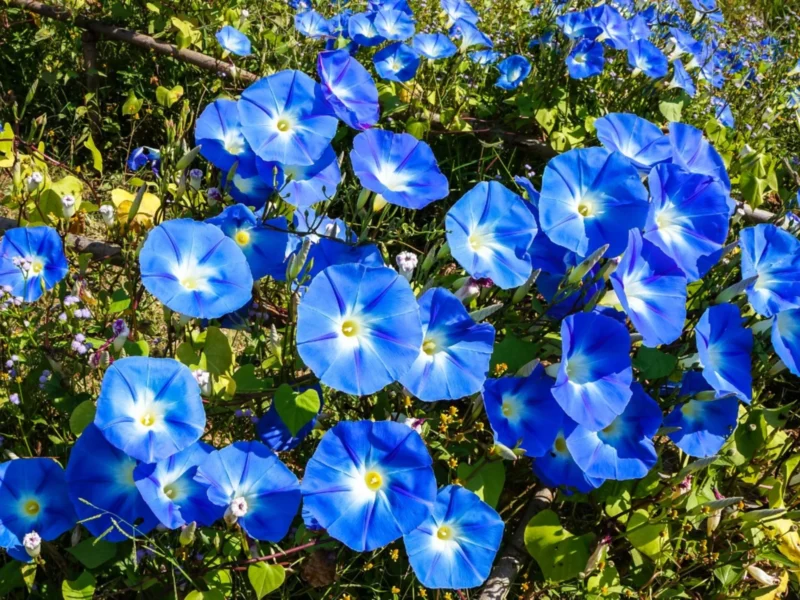Annual or Perennial: Do Morning Glories Come Back Every Year?

Today’s topic of discussion is the enchanting Morning Glories. These delightful vines charm us with their breathtaking flowers each summer, seeming to sprout spontaneously and blanket everything they touch with radiant color. One question that often arises is, “Do Morning Glories Come Back Every Year?” This inquiry has led to a friendly debate about whether these captivating plants are annuals or perennials. So, without further ado, let’s delve in and resolve this mystery once and for all!
Understanding Morning Glories
Basic Characteristics of Morning Glory Plants
Morning glories are a type of flowering vine that can grow up to 15 feet tall with proper support. They come in various colors, including blue, pink, purple, red, white, and yellow. The leaves are heart-shaped, adding an extra touch of charm to this gorgeous plant.
Popular Morning Glory Varieties
There are so many different varieties of morning glories out there! Some popular ones include Heavenly Blue, which has deep blue flowers with white throats; Grandpa Ott, with dark purple blooms; Scarlet O’Hara, with bright red flowers; Flying Saucers, whose petals look like they have been painted by Van Gogh himself; and Early Call, with vibrant pink blossoms that make your garden pop.
Morning Glory Flowers and Their Bloom Time
Morning glory vines produce trumpet-shaped flowers that open each day as the sun rises – hence their name “morning” glories! The blooms typically last only one day before closing back up at nightfall. However, these tenacious climbers will keep producing new buds all season long, so you’ll never run out of beauty to enjoy.
Morning Glories as Annuals and Perennials

Did you know that these lovely blooms can be grown as both annuals and perennials? Let’s take a closer look at what factors influence their growth cycle.
Factors Affecting Morning Glories’ Growth Cycle
The first thing to consider is your growing zone. In colder climates, morning glories will typically grow as annuals since they won’t survive the winter frost. However, if you live in a warmer region with mild winters, they may come back year after year.
Another factor that affects their growth cycle is how much light they get. Morning glories thrive in full sun but can tolerate some shade too.
Soil type also plays a role in whether or not your plants will return each year. They prefer well-draining soil with plenty of organic matter.
Growing Morning Glories as Annuals
If you’re growing your morning glory vines from seed, it’s best to plant them directly into the ground or large containers once all danger of frost has passed. You’ll want to give them plenty of room to climb since this vine loves nothing more than reaching for the sky!
To keep your plants blooming throughout the season, make sure they receive regular water and fertilizer every two weeks or so.
At the end of the growing season, when temperatures start dropping below freezing, cut back the stems above ground level. Dead vines tend to become tangled messes over time, which are difficult to remove during cleanup operations next spring. Leaving behind disintegrating leaves, stems, and fallen seeds make an inviting habitat for insects.
Don’t forget – as soon as nightfall arrives, our beloved flowers close up shop until dawn breaks anew!
Growing Morning Glories as Perennials
If you’re in a warmer climate, you may be able to grow your morning glories as perennials. In this case, it’s important to cut back the vines at the end of each growing season to encourage new growth next year.
Morning glories also benefit from some winter protection if temperatures regularly dip below freezing point.
Remember that these plants can tolerate drier conditions, but regular watering during their growing season will keep them blooming freely and looking their best!
Morning Glory Care Tips
Now that we’ve covered how to grow morning glories as both annuals and perennials let’s talk about how to care for them properly.
Ideal conditions for morning glory growth
To get the most out of your morning glory plants, they need full sun exposure for 6-8 hours each day!
They prefer well-draining soil with plenty of organic matter, which should be kept moist but not waterlogged!
A balanced fertilizer applied every two weeks during active growth (spring through summer) helps ensure abundant blooms too!
How to care for morning glory plants
In addition to a regular watering and fertilizing schedule, pruning is another important aspect of caring for these lovely flowers. To keep your vines healthy and blooming all summer long, remove any spent flowers on a weekly or bi-weekly basis. This ensures that energy is directed towards producing new buds instead of going into seed production.
Deadheading those old blooms encourages more glorious blossoms. So go ahead and snip away! You won’t regret it, I promise! Just remember to always use sharp shears, as dull ones can pinch stems instead of cleanly slicing through, causing harm rather than helping your beauties thrive happily ever after.
And don’t forget – these lovely blooms open early in the morning and close up by late afternoon!
Pruning morning glories: when and how to cut them back
To keep your vines healthy, it’s important to prune them regularly. Cutting back spent blooms encourages more glorious blossoms to form! The best time for pruning is in late winter or early spring before new growth starts.
When you’re ready to prune, start by removing any dead or diseased stems. Then look for the oldest, thickest stems and remove them at ground level. You can also pinch off the tips of the remaining branches if they’ve become too long.
Propagation and planting of morning glory seeds
If you want to propagate your morning glories from seed, start by soaking them overnight in warm water. This will help soften up their hard outer shells so that they can germinate more easily.
Plant your seeds directly into well-draining soil after all danger of frost has passed in springtime.
Remember not to overcrowd those little seeds. Allowing a few inches between each one gives them plenty of room to grow freely without competing with other seedlings!
Diseases and pests affecting morning glory plants
Like many plants, morning glories are susceptible to diseases like powdery mildew and pests like spider mites & aphids! Always be on the lookout for signs such as yellowing leaves, distorted growth patterns, or curled-up foliage which could indicate that something isn’t quite right.
The good news? There are ways we can prevent these issues from happening! First, make sure not to overwater – wet leaves provide breeding grounds for fungi, while dry ones discourage fungal development.
Secondly, inspect your plants periodically, checking for the presence of spider mites or webbing. Rinse them away using a water spray bottle immediately upon detection!
Finally, invest some ladybugs release around the garden – natural predators who love nothing better than feasting on aphids & other common pests.
Do Morning Glories Come Back Year After Year?

Well, butter my biscuits! That’s a question that has been asked more times than I can count. The answer is not as straightforward as you might think. Morning glories are gorgeous vines that produce striking flowers in the morning, but their return year after year depends on a few factors.
Factors Influencing the Return of Morning Glories
First off, let’s talk about whether your morning glory plants were grown from seeds or purchased as young plants. If they were planted from seeds and left to grow naturally without any interference from humans or pests, then they may come back every year.
However, if you live in an area with harsh winters or plant your morning glories late in the season when there isn’t enough time for them to establish properly before winter arrives- well bless your heart -they may struggle to survive and won’t return next spring.
Other factors such as soil quality and moisture levels also play a role in determining whether morning glories will be able to come back each year. In areas with high humidity levels during summer months, these beautiful blooms could become victims of fungal diseases which will prevent their growth even before winter sets in.
How To Improve The Chances Of Morning Glories Coming Back
What can we do to encourage our beloved morning glories’ comeback? First of all, make sure that we’re planting them at an appropriate time of the growing season for our specific location so they have sufficient time to establish themselves before winter comes knocking on our doors.
A good tip is cutting back spent flowers regularly; this encourages new growth and helps maintain strong stems throughout each growing cycle.
If your climate allows it (and oh honey how lovely would it be!) consider covering your outdoor pots/vines with protective material like burlap sacks during colder weather months.
Remember also to have patience because sometimes despite all efforts some plants just won’t return next year. It could be because of pests, disease issues, or simply the fact that they’ve reached their lifespan.
Conclusion
In conclusion, nurturing Morning Glories is a gratifying journey that demands a good measure of patience and care. The burning question – “Do Morning Glories Come Back Every Year?” – has no definitive answer. The resurgence of these plants each year holds no guarantees; however, by sowing them at an opportune moment during the growth season, regularly pruning them to stimulate new growth, and ensuring the sustenance of robust stems throughout each cycle, you certainly enhance your odds of success. So, let’s all exercise our green thumbs and relish the sight of those exquisite blooms springing to life!